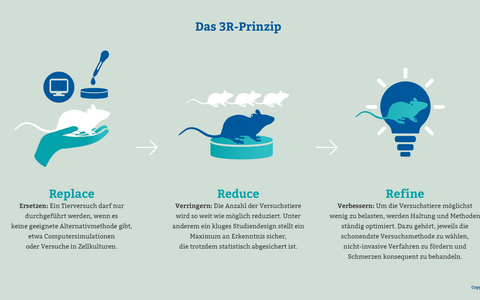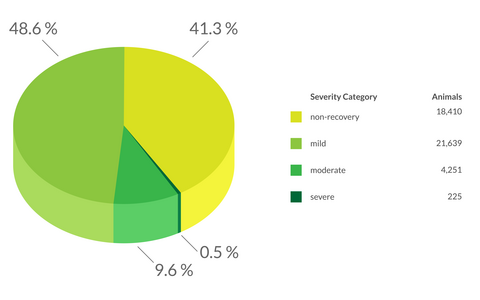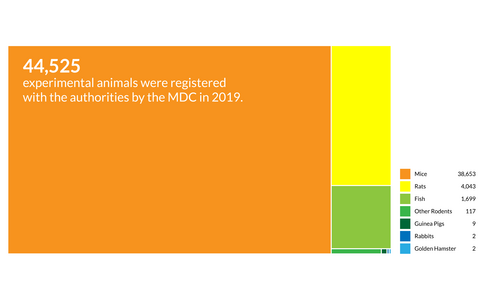Laboratory animal report for 2019
The decline in the number of laboratory animals used at the MDC to 44,525 can be attributed to several factors. Fluctuations occur whenever projects get underway or are completed, or whenever a new lab is opened or an existing one is closed. But the decline is also due to the fact that the biomedical research at the MDC rigorously follows the 3R principles.
3R principles at the MDC
Guided by the principles of “replace, reduce, refine,” scientists, animal welfare officers and veterinarians work together to reduce the overall number of animals used in the MDC’s research, to refine the way studies are carried out on mice, rats and fish, and to constantly develop new methods and techniques.
In most cases, MDC researchers conduct studies on cell or tissue cultures or with computer models. They are also creating new methods to analyze medical problems, for example, with mini-organs (organoids) and other stem cell technologies.
When animal studies are required, modern omics technologies allow enormous amounts of data to be collected from very few experiments. What’s more, methods such as genome editing create animal models that more closely resemble human diseases than ever before. The MDC is also expanding its facilities for non-invasive techniques.
Basic research relies on laboratory animals
Animal studies help many people to lead longer and healthier lives.
“I’m pleased about the progress we’ve made thus far. We will continue to strengthen our efforts,” says Professor Thomas Sommer, interim Scientific Director of the MDC. The MDC’s Preclinical Research Center (PRC), which is scheduled to open later this year, will provide scientists with the optimal conditions for success. The PRC is being outfitted with state-of-the-art equipment for carrying out the latest microscopy methods and with other minimally invasive technologies for animal trials. “Yet basic medical research is still dependent on laboratory animals. We need them in order to analyze how diseases originate and to develop new drugs and therapeutics over the long term,” Sommer stresses. Research teams at the MDC are studying widespread diseases like cancer, cardiovascular disease, and diseases of the nervous system, as well as rare diseases. “Animal studies help many people to lead longer and healthier lives,” Sommer says.
When conducting animal studies, it is essential to keep any distress or suffering to a minimum. Germany has some of the toughest animal welfare laws in the world. The protection of animal welfare has been enshrined in the German Constitution since 2002. The anticipated scientific and medical benefits of each study must be weighed against the suffering and distress caused to the laboratory animals. In order determine the degree of suffering and distress, the Directive 2010/63/EU of the European Parliament sets forth different severity categories. These range from “non-recovery” to “severe.”
The largest number of laboratory animals at the MDC were used in scientific procedures classified as “mild” (see diagram), while 18,410 were used in procedures classified as “non-recovery.” A total of 225 laboratory animals – or about 0.5 percent – were used in ‟severe” procedures, down from 0.8 percent last year.
Severe procedures are those in which the animals are likely to experience severe pain, suffering, or distress, as well as those that are likely to cause severe impairment of the well-being or general condition of the animals. Procedures in which animals are likely to experience moderate but long-lasting pain, suffering or distress are also classified as “severe.”
While the number of mice used in studies in 2019 fell sharply (down by 10,543), the number of rats and zebrafish used increased (up by 2,126 and 762, respectively).
Further information
- The Max Delbrück Center for Molecular Medicine (MDC)
-
The Max Delbrück Center for Molecular Medicine in the Helmholtz Association (MDC) is one of the world’s leading biomedical research institutions. Max Delbrück, a Berlin native, was a Nobel laureate and one of the founders of molecular biology. At the MDC’s locations in Berlin-Buch and Mitte, researchers from some 60 countries analyze the human system – investigating the biological foundations of life from its most elementary building blocks to systems-wide mechanisms. By understanding what regulates or disrupts the dynamic equilibrium in a cell, an organ, or the entire body, we can prevent diseases, diagnose them earlier, and stop their progression with tailored therapies. Patients should benefit as soon as possible from basic research discoveries. The MDC therefore supports spin-off creation and participates in collaborative networks. It works in close partnership with Charité – Universitätsmedizin Berlin in the jointly run Experimental and Clinical Research Center (ECRC), the Berlin Institute of Health (BIH) at Charité, and the German Center for Cardiovascular Research (DZHK). Founded in 1992, the MDC today employs 1,600 people and is funded 90 percent by the German federal government and 10 percent by the State of Berlin.








